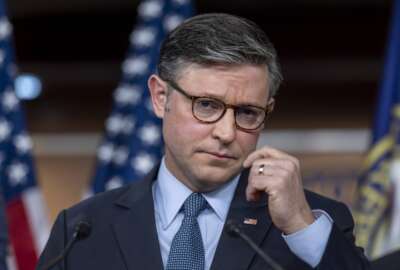USPS cuts 7,500 jobs, offers $20,000 buyouts
The Postal Service will offer $20,000 early retirement incentives to administrative employees, who must make a decision on whether to leave USPS by late April. RIF...
By Jared Serbu
Reporter
Federal News Radio
The Postal Service will eliminate 7,500 positions in the coming year as part of a redesign that Postmaster General Patrick Donahoe said would save the organization $750 million per year.
USPS will offer affected employees, who are non-union, administrative and managerial workers, buyouts valued at $20,000 over two years. It remained unclear whether the postal system reorganization would result in any layoffs, or whether USPS would be able to achieve its staff reduction goals through attrition, grade changes and buyouts alone. Employees have until April 25 to make a decision on whether to accept the retirement incentive. USPS said it expects to issue reduction in force notices a month later.
Among the staff reductions are 2,500 supervisors, 2,000 postmasters and 3,000 administrative employees, USPS executive vice president Anthony Vegliante told Federal News Radio in an interview. No decisions have yet been made on the closure of any of the nation’s 32,000 post offices, an arduous process that requires several layers of bureaucracy and a period of public input, a USPS spokesman said.
An announcement posted Wednesday to a USPS website for employees said the agency would offer affected staff with at least 25 years of service (or 20 years of service if over the age of 50) incentives for voluntary early retirement to be paid out in two $10,000 installments. USPS would fund the payments with the money it would otherwise spend in wages, the announcement said.
Vegliante said the Postal Service would cap the number of early retirements it accepts under the incentive plan at approximately 4,000.
The affected members of the postal workforce include career employees who are not part of collective bargaining units, assigned to USPS headquarters, headquarters field units, area offices and district customer service offices.
USPS also said it would implement a reduction in force “avoidance period,” which will run through May 24. During that time, affected employees can voluntarily move to a lower grade position and be offered salary and grade protection. On May 25, the Postal Service will issue RIF notices to any remaining affected workers, telling them that they are either being laid off or reassigned.
“Historically we’ve done other things, but in this case, the RIF avoidance is the voluntary early retirement and an incentive to take that early retirement,” Vegliante said. “People who are optionally eligible will also be incented.”
The Postal Service also will close seven district offices around the country, USPS said in a statement. The locations slated to be shuttered include Columbus, Ohio, South East Michigan, Northern Illinois, South East New England, South Georgia, Big Sky, Mont. and Albuquerque.
Meanwhile, the Postal Regulatory Commission dealt another of Donahoe’s cost-cutting plans a blow Thursday when it issued an advisory finding on the savings the Postal Service would realize under a proposed cancellation of Saturday delivery service.
In what the PRC said was a cautious, “middle ground analysis,” the panel concluded that USPS had vastly overestimated the savings it would realize by moving to a five-day delivery schedule. USPS has estimated its annual savings under the plan at $3.1 billion. The commission found the savings would likely be closer to $1.7 billion, and would only be realized three years after implementation.
“The Postal Service remains a vital, beloved and important institution facilitating economic growth, aiding small businesses, enhancing communications and unifying the nation,” PRC chairwoman Ruth Goldway said in a statement. “A decision to change the existing patterns of postal communications and delivery should be made with care.”
Vegliante said USPS continued to view the option to move to five-day delivery, which would require Congressional approval, as vital to the institution’s future fiscal health.
“It’s critical that we have the ability to deal with our infrastructure going forward,” he said. “Going from six to five (days) is a way you can deal with your infrastructure costs. I think it’s critical that we have the ability to do that, which we don’t have today. Whether it’s today, tomorrow or whenever, in the environment that we’re in, with the change in mailing habits, we have to look at controlling costs and infrastructure.”
(Copyright 2011 by FederalNewsRadio.com. All Rights Reserved.)
Copyright © 2025 Federal News Network. All rights reserved. This website is not intended for users located within the European Economic Area.





